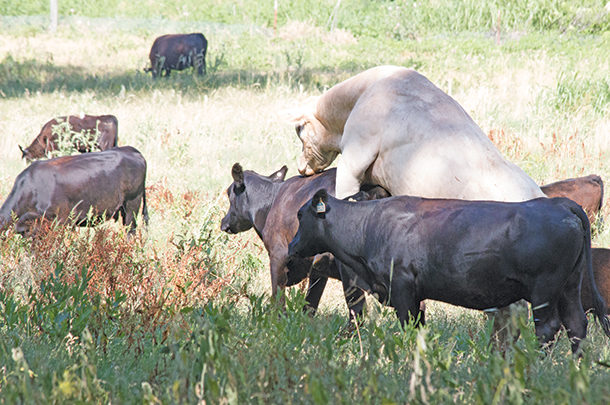Every year, large amounts of money are invested in bulls grabbing a producer’s fancy, and buyers wager on them to increase production and profit in their herds. Then a breeding soundness exam (BSE) might disqualify one due to low sperm counts. Lameness may put another on the sideline. Even when they make it to the breeding pasture, an unforeseen low libido could derail a favorite’s momentum.
To top it off, these males might put each other out of action, assisted by uninformed and careless sorting, penning and handling. Fights for dominance can cause injury, decrease pregnancy rates and ruin calving distribution.
Expanding the herd sire budget
Even before bulls are purchased, replaced or dropped at the pasture, they warrant their own expanded column in the budget paperwork, says Justin Rhinehart, associate professor, extension beef cattle specialist at the University of Tennessee.
“Our full maintenance cost is not just feed, labor and upkeep. I encourage producers to budget as cost per pregnancy across the board. Examine all the breeding approaches, whether it’s reproductive technology like a timed artificial insemination (A.I.), estrous synchronization (ES), live service or different combinations.”
He prefers to add extra budget for facilities and the damage bulls will cause. When written over three years with the number of covered cows factored in, it can be broken down to a fairly accurate cost of pregnancy.
Keeping order at the pasture
To help keep order at the pasture, Rhinehart prefers to group females into single-bull units of 25 to 35 cows depending on age, but he understands this isn’t always possible with bigger- scale production.
“If multiple sires are needed, I definitely want to stay away from introducing a brand-new one. Dumping them directly into the cows is not a good approach.”
He says they should be acclimated and separated ahead of time by age, size and weight. Even better is if they were raised together.
If ranchers are worried about volatile situations due to lack of familiarity, he notes some producers rotate bulls in and out of pastures as a type of insurance policy.
“Even if they’ve passed the BSE, one may have a low libido. Some keep them with a group of females for two to three weeks and then shift them into another. It can redistribute the genetics and give them a fresh set of new cows to work with that might just enhance their libido to some degree. It guards against lower serving capacity and helps spread out the risk.”
Assembling the pieces before breeding
Jaymelynn Farney, associate professor and extension specialist at Kansas State University, urges her producers to acclimate similar bulls prior to breeding season, although she recognizes pen limitations might be a concern.
 Groups of fertile, more mature sires in a full herd have a dominant streak that could push aside younger bulls in the pasture. Photo by David Cooper.
Groups of fertile, more mature sires in a full herd have a dominant streak that could push aside younger bulls in the pasture. Photo by David Cooper.“They should be grouped by age as much as possible. It doesn’t have to be only 3- or 4-year-olds, but a ‘mature’ pen helps if space is limited. Keep yearlings and virgins together. They’ll go through their dominance ritual and determine a pecking order. If ages are mixed, it’s really an invitation to injury for the younger, lighter bulls.”
She advises an early division to get this phase over with. If they’re still fighting for dominance when they arrive at the pasture, they won’t be breeding enough females.
Guarding against pregnancy rate complications
Farney believes mismanaged herd sires can also lead to negatively affected rates come pregnancy checking time.
A mature and a yearling with the same cows could lead to a lower pregnancy rate, primarily since the older bull will try to control the action, and neither will do a thorough job.
Or the mature animal may not have enough time and resources to maintain his semen supply to appropriately breed what might essentially become twice the number he was meant to cover.
“Even if you have two dominants in the same pasture, at some point one of them needs to come out the winner. If they’re constantly fighting, you might have to split them and rearrange things. Either way, your pregnancy rates could be in trouble,” says Farney.
Megan Van Emon, Montana State University Extension beef cattle specialist, interacts with many cow-calf producers using multisire pastures and says managing bulls is a balancing act. Groups of older, more dominant bulls can drive subordinates away from cows in standing heat even though they have surpassed their own capacity.
“In some larger operations of 20 sires, if four out of the five most dominant are infertile, there goes a lot of your calf crop. It’s hard to get a handle on each specific situation, as they are still social creatures and will establish a dominance structure.”
Handling other potential problems
Rhinehart notes even if a disjointed social structure doesn’t decrease the overall pregnancy rates, data shows it can negatively impact calving distribution.
“Pounds of calf weaned per cow exposed can really take a hit,” he says. “While the same number of animals might be bred, more calves born at the tail end of the season can add up to an extensive loss of weight with younger, lighter calves.”
“The distribution curve will get shifted, and you end up with a later, average calving date. It affects the next year, especially for first-calf heifers. Their average postpartum interval is shorter, compounding the delay and impacting the coming years.”
Rhinehart believes a way to tip the scales is to allow some leeway on the bull-to-cow ratio. “If we’ve calculated the ratio at the maximum we expect them to service, and one bull is punching above his weight, he’s going to play out quick, maybe get injured, lose a lot of weight. He won’t keep up with the nutrition. Reducing the bull/female ratio takes some pressure off.”
Even when BSEs are completed, health is monitored, and social structure is shaped as accurately as possible, events don’t always play out as desired.
Occasionally, no matter how hard you try, the writing is on the wall, Rhinehart says. “Sometimes you have to make the hard decision to get rid of a bull that never behaves himself. It’s just the way it happens.”











